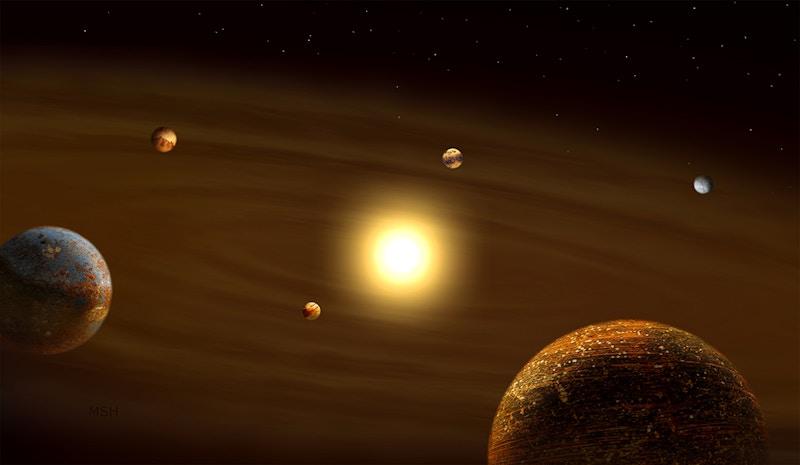Pint-Size Planetary Systems Aren’t Into Heavy Metal

Small planetary systems with multiple planets are not heavy-metal fans, new observations suggest.
Researchers at the Flatiron Institute and Yale University have discovered that compact, multiple-planet systems are more likely to form around stars that have lower amounts of heavy elements than our own sun. This result runs counter to previous research, which focused on stars with higher metallicity.
Such systems, composed of many small planets, are prime candidates for extraterrestrial life, says study coauthor Dan Foreman-Mackey, associate research scientist in the Flatiron Institute’s Center for Computational Astrophysics (CCA). “This work suggests that these systems are more common than previously thought,” he says. “Following up on this result could increase the rate of discovery of potentially habitable exoplanets.” The study appeared October 24 in The Astrophysical Journal Letters.
The researchers looked at 700 stars and their surrounding planets. They considered any element heavier than helium — including iron, silicon, magnesium and carbon — to be a heavy metal.
“We used iron as a proxy,” says study coauthor John Michael Brewer, associate scientist at Yale and an extramural member of the CCA’s Astronomical Data group. “These are all elements that make up the rocks in small, rocky planets.”
An abundance of compact, multiplanet systems around low-metallicity stars suggests several things.
First, it may indicate that there are many more of these systems than previously assumed. Until recently, research instruments did not have the necessary precision to detect smaller planets and instead focused on detecting larger planets. Now, with the advent of technology such as the Extreme Precision Spectrometer (EXPRES) developed by study investigator and Yale astronomy professor Debra Fischer and her team at Yale, researchers will be able to find smaller planets.
In addition, the new study suggests that small planetary systems may be the earliest type of planetary system, making them an ideal place to search for life on other planets. “Low-metallicity stars have been around a lot longer,” Brewer says. “That’s where we’ll find the first planets that formed.”
Fischer demonstrated in 2005 that higher metallicity in stars increases the probability of forming large, Jupiter-like planets. This provided strong support to the core-accretion model for gas-giant planet formation and established this as the leading mechanism for planet formation.
Understanding the formation of smaller planets has been more elusive.
“Our surprising result — that compact systems of multiple small planets are more likely around lower-metallicity stars — suggests a new, important clue in understanding the most common type of planetary system in our galaxy,” says study investigator Songhu Wang, a 51 Pegasi b fellow at Yale.
Another tantalizing possibility to explore, according to the researchers, is the connection between iron and silicon in the birth of planets. The new study shows a high silicon-to-iron ratio in stars with lower metallicity.
“Silicon could be the secret ingredient,” Fischer says. “The ratio of silicon to iron is acting as a thermostat for planet formation. As the ratio increases, nature is dialing up the formation of small, rocky planets.”
The National Science Foundation helped support the research. The Heising-Simons Foundation supports Wang’s fellowship.
For more information, please contact [email protected].


